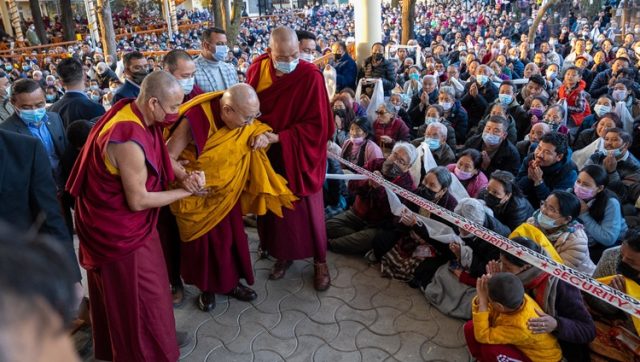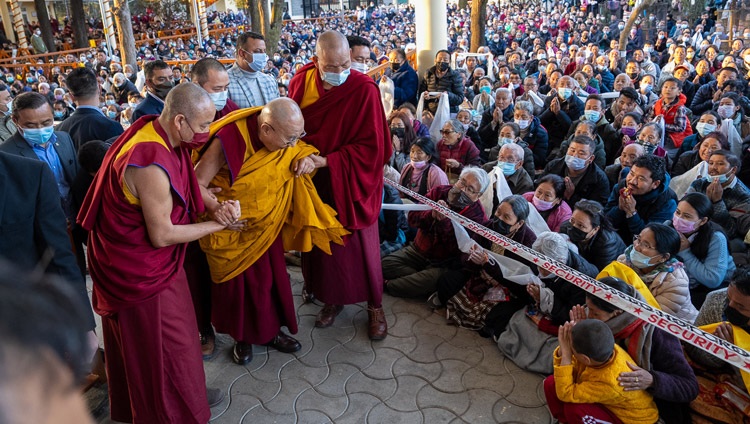
His Holiness the Dalai Lama greeting a young child as he walks to the Tsulagkhang to bestow the Chakrasamvara Empowerment in Dharamsala, HP, India on March 9, 2023. Photo by Tenzin Choejor
Thekchen Chöling, Dharamsala, HP, India, 9 March 2023: The sun had barely risen this morning when His Holiness the Dalai Lama set out to walk from the gate of his residence to the Tsuglagkhang. As is his wont, he smiled and waved to members of the public in the yard to left and right. Here and there he stopped to exchange a few words with children at the front of the crowd.
On reaching the temple, as he did yesterday, he first sat on a chair facing the mandala with his back to the audience while he went through the self-generation procedures requisite to his giving the Chakrasamvara Empowerment. As he recited the relevant verses, he looked up at the thangka high on the wall above and saluted the various deities depicted there.
Meanwhile, the congregation recited the Praises to the Twenty-one Taras.
Once he had completed his preparations, His Holiness took his seat on the throne and the ‘Heart Sutra’ was chanted.

His Holiness the Dalai Lama going through self-generation procedures requisite to his giving the Chakrasamvara Empowerment at the Tsulagkhang in Dharamsala, HP, India on March 9, 2023. Photo by Ven Zamling Norbu
“The ‘Heart Sutra’ is very meaningful,” he remarked, “and it’s helpful, when we recite it, to think carefully about what a great teaching the Buddha gave, explaining emptiness and outlining the paths that culminate in enlightenment.”
As he offered a ritual cake to those who might hinder the conduct of the empowerment, His Holiness pointed out, as he did yesterday, that really obstructions and interferences are not out there, but within us. Most obstructive are a strong grasping and clinging to the true or inherent existence of things, as well as extreme self-centredness and self-cherishing attitudes. Such obstructions reflect our negative emotions.
“Things have no independent existence,” His Holiness clarified, “they are merely designated. When we realise this, we can free ourselves from the cycle of existence.
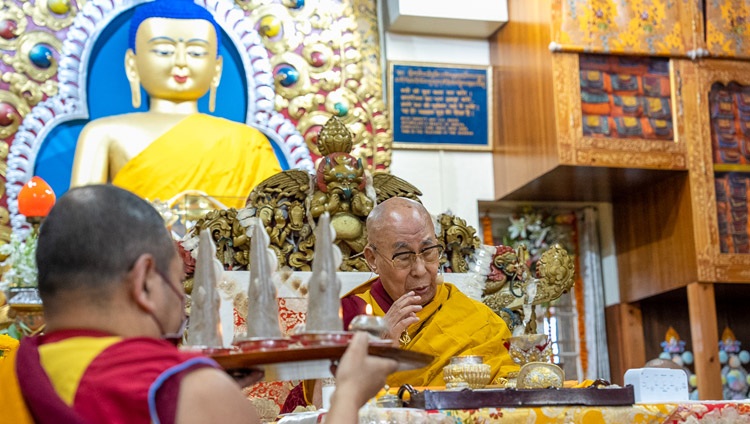
His Holiness the Dalai Lama offering ritual cakes to those who might hinder the conduct of the Chakrasamvara Empowerment at the Tsulagkhang in Dharamsala, HP, India on March 9, 2023. Photo by Tenzin Choejor
“I don’t claim to have any such realization, but I can reflect on the status of things and see that they don’t have any independent or objective existence from their own side. I recognize their lack of independent existence. To this we can add a wish to liberate all beings. Cherishing others rather than yourself alone is a vast aspiration, whereas thinking only of yourself is narrow.
“The ‘Offering to the Spiritual Master’ or ‘Lama Chöpa’ expresses this clearly in the following verses:
“This chronic disease of self-centredness
Is the cause of unwanted suffering.
Perceiving this, may I be inspired to blame, begrudge
And destroy this monstrous demon of selfishness.
Caring for my mothers and seeking to secure them in bliss
Is the gateway to infinite virtue.
Seeing this, may I be inspired to hold them dearer than my life,
Even should they rise up as my enemies.
Since self-centredness is the doorway to all torment,
While caring for my mothers is the foundation for all that is good,
Inspire me to make the core of my practice
The yoga of exchanging myself for others.
“If you cherish others, you’ll have no enemies.
“All our different religious traditions are valuable, but the Buddha’s teaching is unique in identifying the principal factors that give rise to suffering.
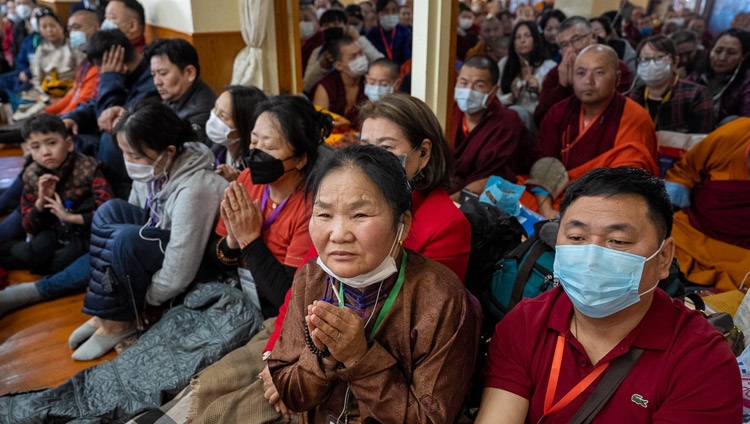
Members of the audience listening to His Holiness the Dalai Lama speaking at the Tsulagkhang in Dharamsala, HP, India on March 9, 2023. Photo by Tenzin Choejor
“I once had a dream of going into the Jokhang in Lhasa where there was a much-revered statue of Avalokiteshvara. He seemed to be beckoning me to him, so I stepped forward and embraced him. And in my dream, he advised me never to lose hope but to practise the teachings with diligence.
“I realized that if you are at peace within yourself, the peaceful atmosphere around you will spread to others. That’s how we can build peace in the world.
“Today, I will give the actual empowerment of Chakrasamvara according to the Krishnacharya tradition. But what we need to do, day and night, is to work to overcome clinging to true existence and our self-cherishing attitudes. Day by day we must try to reduce them. This is what I try to do in my own practice, and if you can do it too, you’ll really become disciples of the Dalai Lama.”
His Holiness commented that there are three traditions of Chakrasamvara practice. The Luipa tradition is practised in the two Tantric Colleges of Gyumé and Gyutö. Then there is the Ghantapada tradition or practice of the Body Mandala. Thirdly there is the Krishnacharya tradition. His Holiness reiterated that he received the empowerment for this tradition from Tagdag Rinpoché when he was young. Since then, he has also done the retreat.
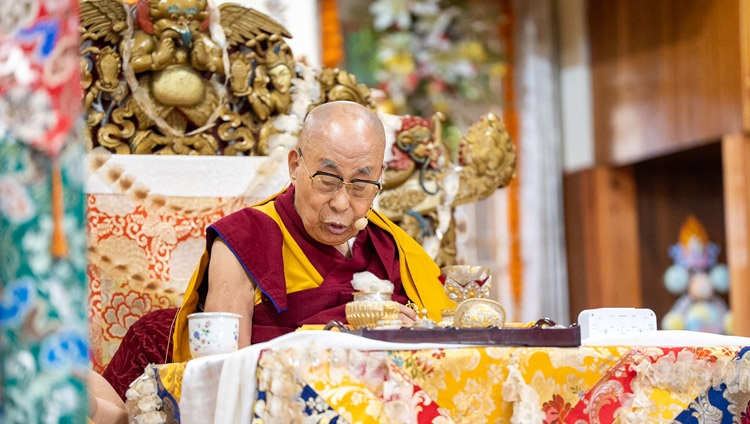
His Holiness the Dalai Lama conferring the Chakrasamvara Empowerment at the Tsulagkhang in Dharamsala, HP, India on March 9, 2023. Photo by Tenzin Choejor
His Holiness then advised the disciples to offer a mandala and make the request, “Please let me enter the city of liberation,” and the empowerment began. Garments representing the lower and upper robes and top-knot of a yogi, as well as a blindfold and garland of flowers, were distributed to key disciples in the congregation principal among whom was the Ganden Tri Rinpoché.
The disciples were advised to imagine transforming into the deity and rise as blue Heruka. They were further advised that if they could overcome the three visions of whitish appearance, reddish increase and black near attainment, as well as the eighty conceptions associated with them, physical and mental consciousness would cease and the spontaneous mind of clear light would be revealed.
His Holiness gave the Bodhisattva Vows again and briefly led the disciples through the all-encompassing yoga mind. As a result, they were to imagine the awakening mind of bodhichitta as a moon disc at their hearts on which stood a five spoked vajra representing an understanding of emptiness.
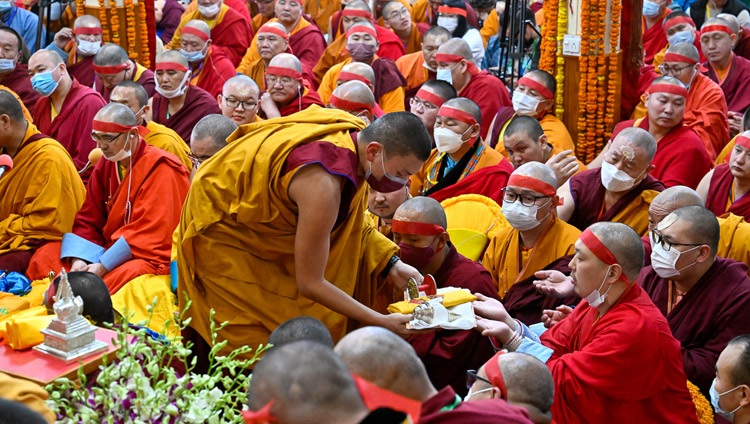
Monks walking through the crowd to let members of the audience touch ritual objects from the Chakrasamva Empowerment conferred by His Holiness the Dalai Lama at the Tsulagkhang in Dharamsala, HP, India on March 9, 2023. Photo by Ven Zamling Norbu
The disciples were advised to imagine passing through the curtain and entering into the mandala. The Lama-deity gave them Tantric Vows and they were exhorted to visualize their ordinary forms dissolving into emptiness and their essential mind and wind-energy transforming into the deity. The Lama-deity counselled that taking and keeping the Tantric Vows are the basis for following in the footsteps of the Mahasiddhas. The disciples were cautioned that Tantra is practised in secret, not proclaimed to others.
His Holiness gave the fivefold Vase Empowerment that includes the Water, Crown, Vajra and Bell, Name and Vajra-master empowerments. The Vase Empowerment grants permission to engage in generation stage practices. These were followed by the Secret, Wisdom, and Fourth or Word Empowerments, which grant permission to undertake completion stage practices. In addition, the Vase Empowerment purifies the body, the Secret Empowerment purifies speech, the Wisdom Empowerment purifies the mind and the Fourth or Word Empowerment purifies all together.
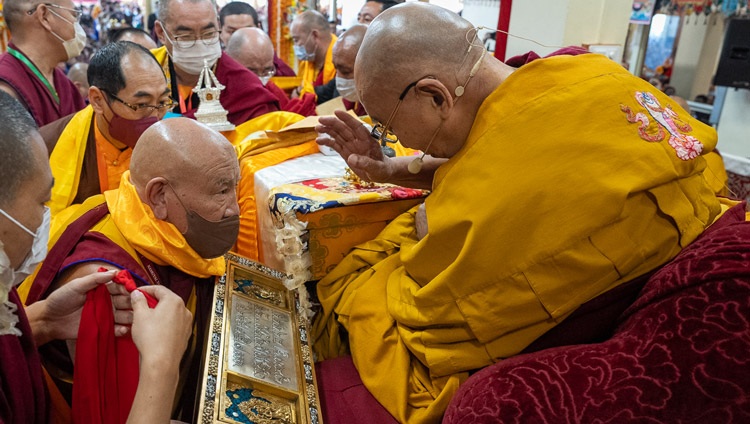
Members of the audience from Mongolia presenting offerings to His Holiness the Dalai Lama during long life prayers after the conclusion of the Chakrasamvara Empowerment at the Tsulagkhang in Dharamsala, HP, India on March 9, 2023. Photo by Tenzin Choejor
Once the empowerments were complete, His Holiness performed the appropriate concluding rites while prayers were said for his long life and a long procession of Mongolians bearing offerings filed through the temple.
As His Holiness walked from the temple to the lift many people on either side of the aisle sought to catch his eye. Some waved, some cheered, others smiled quietly in hope. Down in the temple yard it was the same as he made his way to the golf-cart that would carry him back to his residence in time for lunch.


